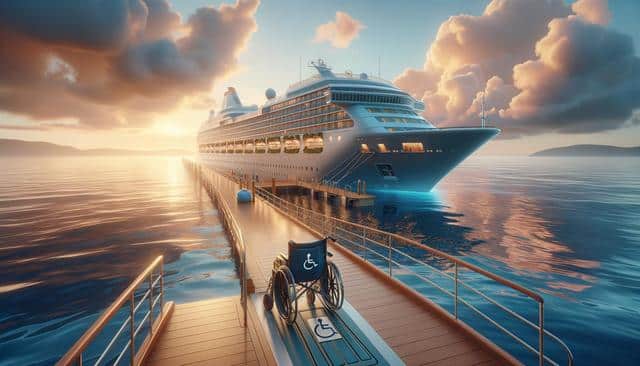
Navigating Accessibility: 5-Day Cruises for Disabled Travelers
Understanding Accessibility at Sea
The cruise industry has made significant strides in recent years to improve accessibility for travelers with disabilities. Many ships are now equipped with features that cater specifically to those with mobility challenges, visual or hearing impairments, and other special needs. A 5-day cruise offers a manageable and enjoyable way to experience the ocean while taking advantage of these enhancements. When considering a cruise, it’s important to look into the ship’s layout, the availability of accessible cabins, and the scope of services tailored for disabled guests. These factors contribute greatly to an enjoyable and stress-free journey.
Some cruise lines provide detailed accessibility reports and specialized booking assistance. Whether it’s wheelchair access, assistance for travelers with limited hearing, or dietary requirements, these services help ensure the trip is as seamless as possible. Choosing a cruise with a solid reputation for accessibility can make all the difference in your travel experience.
Accessible Cabins and Accommodations
One of the first things disabled travelers should consider is the availability of accessible cabins. These rooms are designed with wider doorways, roll-in showers, grab bars, lowered sinks, and emergency call buttons to ensure safety and convenience. On a 5-day cruise, comfort and practicality are key, and choosing the right cabin can improve the overall experience significantly.
Features often found in accessible staterooms include:
- Spacious layouts for easy wheelchair maneuverability
- Roll-in showers with seating
- Bathroom grab bars and emergency pull cords
- Visual and auditory alert devices
It’s advisable to book well in advance, as the number of accessible cabins is limited and in high demand. Consulting with a cruise line’s special needs department can also help match travelers with appropriate accommodations and ensure all accessibility requirements are met.
Onboard Services and Support
Cruise ships often offer a variety of services to support disabled guests during their voyage. From embarkation assistance to accessible dining and entertainment options, the goal is to deliver an inclusive experience without compromising on enjoyment. Onboard staff are typically trained to provide compassionate and respectful service, helping to address individual needs as they arise.
Notable onboard services may include:
- Priority boarding and disembarkation
- Accessible seating in theaters and dining venues
- Sign language interpreters for select sailings
- Rental equipment such as scooters or hearing devices
Before setting sail, travelers are encouraged to notify the cruise line of any specific requirements. This allows the crew to prepare in advance and ensures that everything from shore excursions to onboard activities is accessible and enjoyable.
Shore Excursions and Port Accessibility
One of the highlights of any cruise is the opportunity to explore new destinations. For disabled travelers, the accessibility of shore excursions can vary widely depending on the port and the local infrastructure. Many cruise lines now offer excursions that are specifically labeled as “accessible,” meaning that they are designed to accommodate wheelchairs and other mobility aids.
When reviewing excursion options, look for:
- Ramp-equipped transport vehicles
- Flat, paved walking paths at attractions
- Guides trained to work with guests with disabilities
- Restrooms that are accessible and well-maintained
Travelers should also consider ports that use docking rather than tenders, as boarding a small boat to reach shore may not be feasible for everyone. Cruise lines typically indicate which ports are wheelchair-friendly and can help plan excursions accordingly.
Planning and Booking Tips
Booking a cruise as a disabled traveler requires additional research and preparation, but with the right approach, the experience can be very rewarding. Start by selecting a cruise line known for its accessibility features and customer service. From there, consulting with a travel advisor who specializes in accessible travel can be extremely helpful.
When planning your cruise, consider the following tips:
- Book early to secure accessible cabins
- Request medical equipment rentals in advance
- Notify the cruise line of any dietary or medical needs
- Review the ship’s deck plans for accessibility
- Check the accessibility of each port of call
Finally, be sure to carry documentation of your medical condition and any prescriptions, and travel with a companion if additional assistance is required. With careful preparation, a 5-day cruise can offer a revitalizing escape that is both accessible and enjoyable.
Conclusion: Creating Inclusive Travel Experiences
For travelers with disabilities, a 5-day cruise can be a relaxing and memorable way to explore new places while enjoying the comforts of a well-equipped ship. As accessibility continues to improve across the cruise industry, more inclusive experiences are becoming available to a diverse range of passengers. By selecting the right cruise, planning ahead, and utilizing the support services offered, disabled travelers can enjoy a fulfilling and accessible vacation at sea. Whether it’s a first-time cruise or a familiar journey, these short itineraries provide a welcoming gateway to the joys of ocean travel.


